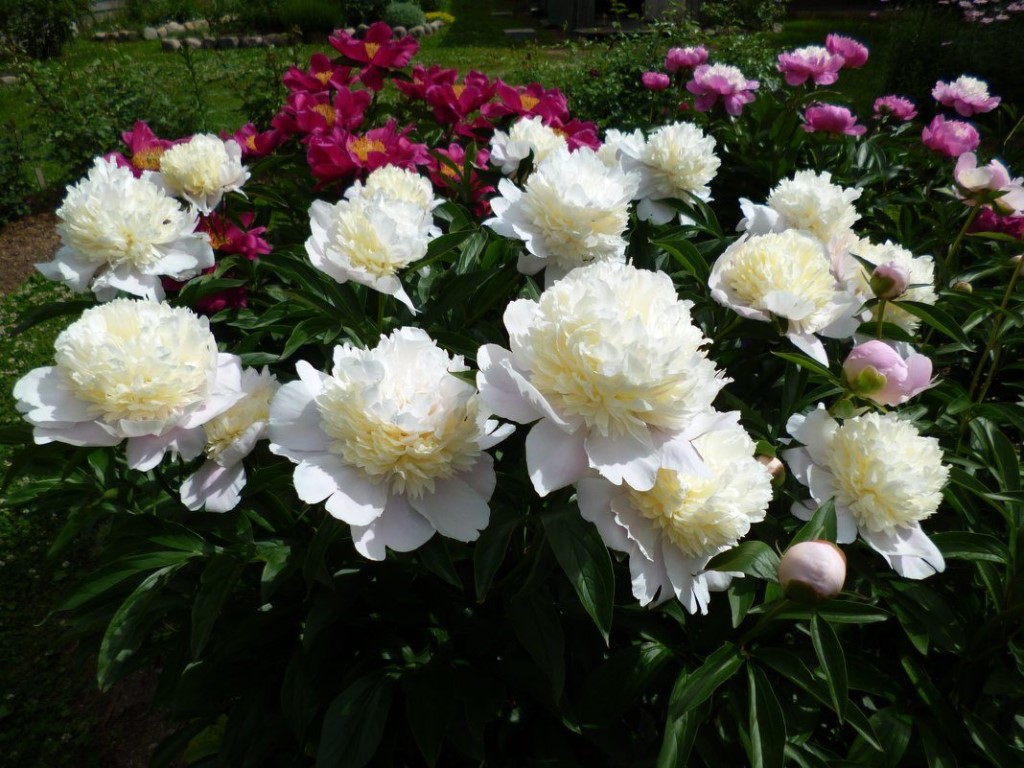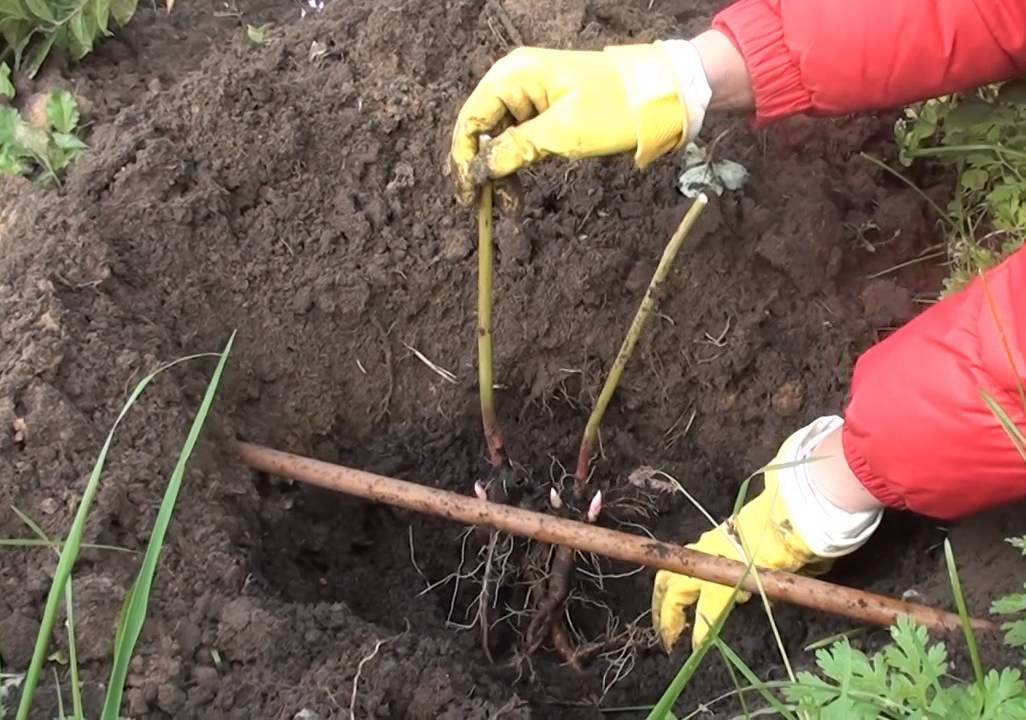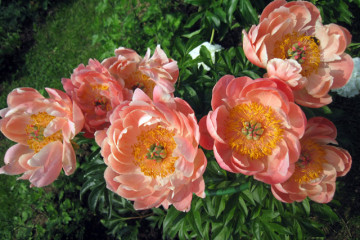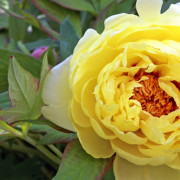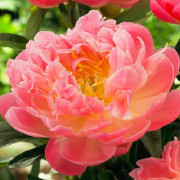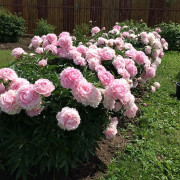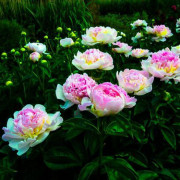Peony Primavera (Paeonia Primevere) - characteristics of the variety
Content:
Peony Primavera serves as a decoration of the garden area from late May to mid-June. It has large, anemone-shaped, milky buds. The bushes quickly adapt after planting, are unpretentious to care for.
What is this grade
The Primavera peony was bred more than a century ago. The breeding works were carried out by French specialists. They crossed a terry peony and a Japanese peony. Primavera is still very popular with flower growers.
Description, characteristic
Shoots reach a height of 90 centimeters. Every year more and more of them grow on the bush. The leaves are large, colored with a dark green palette.
The tops of the shoots are crowned with flowers up to 20 centimeters in diameter. They are anemic type. The lower petals are white or pale pink. The middle is light yellow.
The buds begin to blossom at the end of May. Flowering lasts about 3 weeks. In one place, the bushes can grow up to 20 years. The variety is frost-resistant, no shelter is required for the winter.
Advantages and disadvantages of the variety
The positive qualities of Primavera include:
- unpretentious care;
- early flowering time;
- decorativeness;
- frost resistance;
- the ability to use cut flowers.
Negative qualities include average resistance to diseases and pests.
Use in landscape design
Primavera herbaceous peony is planted singly, in composition with peonies of other varieties. It can be combined with roses, lilies, petunias, phloxes, asters. Peony is often decorated in the form of a border, planted as a hedge.
Growing
Planting material is purchased in the garden center from reliable sellers.
Planting by root cuttings
Usually, root cuttings are planted on the paeonia plot. If a bush is already growing on the site, you can dig it up and cut the processes yourself. Cuttings are planted in prepared holes.
What time is the boarding
Peonies are planted in spring or autumn. Experienced gardeners recommend carrying out the procedure in September. Then he will develop the root system well and be able to lay flower buds.
Location selection
The territory for planting a peony is selected well-lit by the sun. It should be open space, or the south side of the buildings. When planted in the shade, the crop may not bud. The site must be protected from cold winds.
How to prepare the soil and flower
The territory is cleared of plant residues. A hole is dug 2 weeks before planting the bushes. If the soil is poor, humus, superphosphate, wood ash are introduced into it.
The root system is placed in a solution of potassium permanganate for 2-3 hours. This is necessary to disinfect the planting material. Then it is placed in a growth stimulator for a few minutes.
Planting procedure step by step
The peony is planted as follows:
- dig a hole measuring 60 × 60 × 60 centimeters;
- a drainage layer is laid on the bottom;
- fill in nutritious soil;
- a seedling is placed in the middle, covered with soil;
- watered.
The root circle is covered with mulch. The top of the tuber should be about 6 centimeters below the surface of the soil.
Seed planting
This method of culture propagation is usually not used by flower growers. It is time consuming. In addition, the qualities declared in the description of the Primavera peony may not be transmitted. Therefore, the seed propagation method is used by breeders to develop new varieties.
Plant care
Care consists in timely watering, regular feeding, loosening and mulching the soil. The faded buds need to be cut off, otherwise the peony may not bloom next year.
Watering and feeding
Water the Primevere peony after the topsoil has dried. The procedure is carried out in the morning or in the evening. In hot, dry weather, peonies are watered at least 1 time a week. 10-15 liters of water are poured under each bush.
If the peonies were planted in fertile soil, they begin to feed the peonies in the 3rd year. Organic and mineral fertilizers alternate. Use the nutrient solution according to the instructions on the package.
Mulching and loosening
The soil around the bushes is slightly loosened to allow air to reach the root system. At the same time, weeds are cut, which can be carriers of pathogenic microorganisms and harmful insects.
To preserve moisture in the ground, the root circle is mulched with peat, hay, straw, sawdust. By decaying, the substances will serve as additional food for plants.
Preventive treatment
To prevent the appearance of diseases and pests, the bushes are sprayed with insecticides and fungicides several times per season. To do this, use Topaz, Fitosporin-M, Fitoverm. It must be remembered that the treatment with chemicals cannot be carried out during the flowering of plants.
Blooming peony Primavera
Dissolving buds reach a diameter of 20 centimeters. The flowers are anemic: the lower petals are painted with a white-pink palette, the middle is pale yellow.
A period of activity and rest
Flowering occurs at the end of May. In the northern regions, the buds can begin to bloom in early summer. After flowering, the bushes continue to accumulate nutrients. With the onset of cold weather, a period of rest begins.
Care during and after flowering
During the period of dissolution of buds, peonies are watered, diseased, broken shoots are cut off. At the beginning of budding, during the flowering period and after it, mineral fertilizers are applied.
What to do if it does not bloom, possible reasons
Peonies usually bloom the next year after planting. If it doesn't, the bushes may be lacking sunlight. Flowers may stop forming if the planting is too low or high. Having eradicated the reasons, the gardener will admire the flowering of peonies for 18-20 days a year.
Peonies after flowering
After the buds dry, the bushes continue to develop. In summer, only flower shoots are cut. All other stems are removed almost to the very root in the middle of autumn.
Transfer
Bushes over 6-7 years old grow many shoots. As a result, they begin to lack nutritional area, the flowers grow small. At this age, they are divided into parts. Each piece is transplanted into a separate well. The procedure is performed in spring or autumn.
Pruning
At the end of June, the faded buds are cut off. Broken, dry branches are removed throughout the season. Shoots are completely cut in October, before the onset of frost.
Preparing for winter
Milk-flowered peony Primavere is a frost-resistant culture. She does not need shelter for the winter. In the middle of autumn, it is enough to carry out water-charging irrigation. The root circle can be covered with a low layer of mulch.
Diseases, pests and ways to control them
With too frequent and abundant watering, the root system of the bushes can be affected by gray rot. For prevention and treatment, Hom or copper sulfate is used.
If there is a large amount of rainfall, and even at low air temperatures, powdery mildew can form on the leaves and stems. In this case, use Topaz or Fitosporin.
Of the harmful insects, the peony can be chosen by aphids. By sucking out the cell sap, it weakens the plants.
Primavera is a milky-flowered peony. Caring for him is simple. Even a beginner can grow it. Plants need to be watered in a timely manner, fed, cut off the faded buds. From the age of 6, the peony is propagated by dividing the bush.

